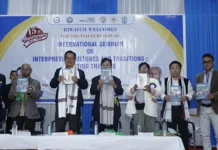Flights Of Fantasy
[ M Panging Pao ]
The Anglo-Abor war of 1894 was a major expedition launched by a large British force consisting of 550 armed soldiers, 1,500 porters and two 7-pounder guns, led by Captain Maxwell, accompanied by Sadiya political officer JF Needham. This large force attacked the Adi villages of Bomjir, Dambuk, Silluk, Mebo, Ayeng, Bodak, Padu, Silli and Damroh in the Siang-Lower Dibang valley areas of Arunachal. Fierce battles were fought against the British forces by warriors of Dambuk, Mimesipu, Silluk, Damroh, Adi Pasi, Padu, and Silli villages, inflicting heavy losses on the British forces. The British forces could not reach their intended target, Damroh, and were forced to retreat, beaten back by the Adi warriors.
However, it was in Bodak, on the banks of the Siang river in East Siang district, that the Adi warriors inflicted one of the largest massacres of British forces in entire Indian history. After overcoming Bomjir, Dambuk, Silluk, Mebo and Ayeng, the British expedition paused at Bodak with the final target being Damroh village in the present Upper Siang district. To support the campaign, the British forces set up a supporting base camp in Bodak, leaving behind their major supplies along with a force consisting of one subedar, 17 sepoys, and 44 coolies (total 62).
The main force left Bodak and proceeded towards Damroh on 22 February, 1894. However, this force was attacked and harassed by the Adi warriors who had built strong stockades of stones, bamboo/wooden panjis to stop the British advance. The Adi warriors fought pitched battles, inflicting heavy casualties on the British forces, using poison-tipped bows and arrows, spears and swords (yoksas). The British forces failed to reach Damroh village and retreated back. The retreating British force reached Bodak on 4 March, 1894. To the shock of the British forces, the supporting base camp in Bodak was completely gutted and destroyed. The Adi warriors led by Mutling Perme, Kebang Perme, Ketong Perme and other warriors of Ayeng and
nearby villages had slaughtered the entire British detachment in Bodak. Out of the 62 British forces, 60 personnel, including the detachment commander, Subedar Anayat Khan, were killed. Only two survived the massacre. One was missing from the camp, and the other severely wounded jumped into the Siang river and escaped.
It emerged that the Adi warriors entered the camp disguised as porters. Once the signal was given, the warriors whipped out their hidden swords and slaughtered the surprised and shocked British forces. A few warriors stood in front of the armoury and slaughtered all British soldiers rushing to draw their rifles with their yoksas.
While most of us know about freedom fighters like Rani Lakshmi Bai, Tantiya Tope, Chandrasekhar Azad, Bhagat Singh, etc, very few know about one of the largest massacres of British forces which occurred in Bodak in East Siang district of Arunachal Pradesh. A small war memorial named ‘Midu Lireng’ stands at the site to mark this historical event.
Isn’t it time for the government to recognise and honour this historically significant event in Bodak? (The contributor is retired Group Captain, Indian Air Force)




